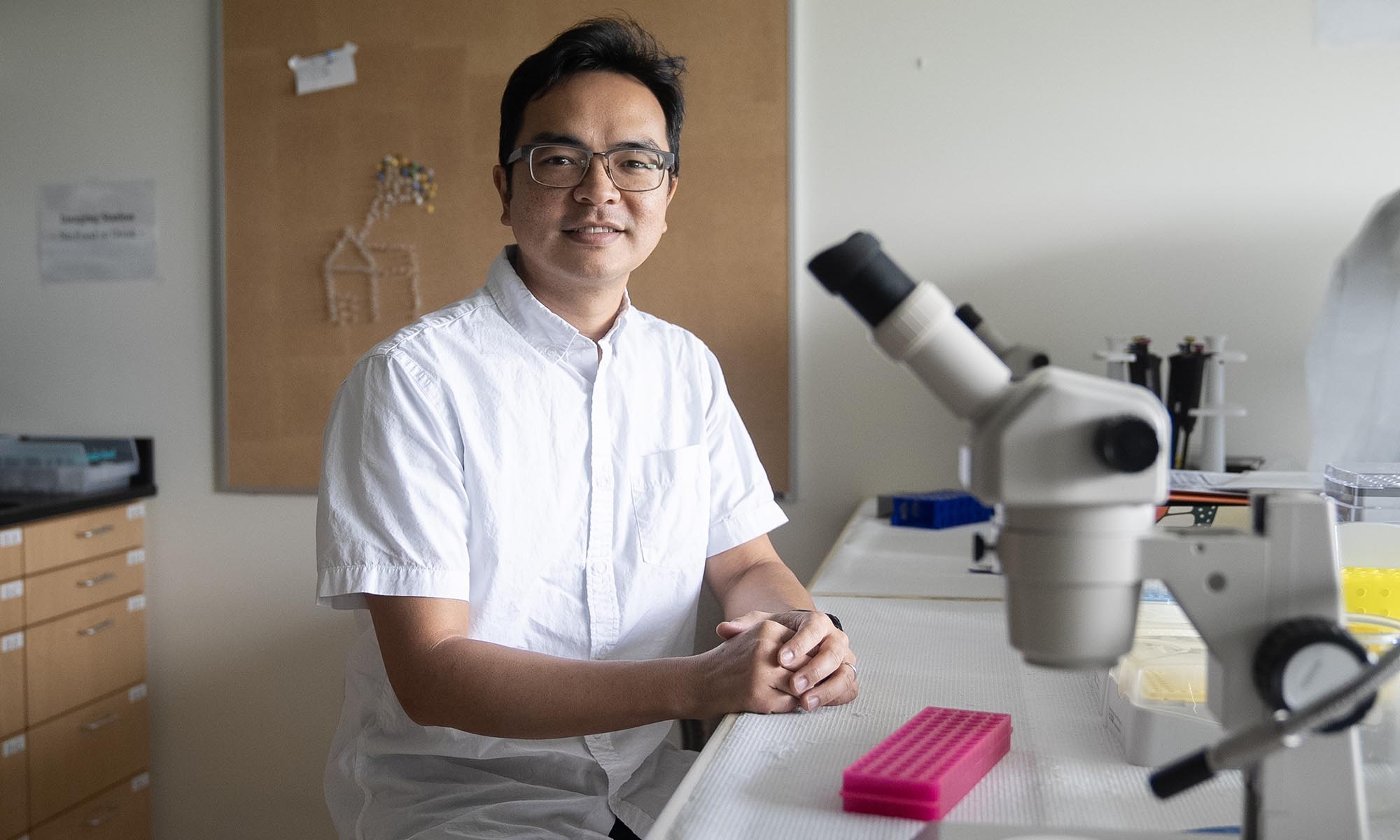At this very moment in the turquoise waters of the Caribbean Sea, living inside certain sponges on kaleidoscopic coral reefs, is a species of tiny and remarkable shrimp named after a Denison University professor.
For the discoverer of the species — Seattle University biologist Kristin Hultgren — naming Synalpheus chaki for assistant biology professor Solomon Chak was an obvious choice. Chak is a leading expert on a group of crustaceans known as snapping shrimp.
Chak was flattered when Hultgren called to tell him her idea for the species name, which was registered in 2022. He is also modest, pointing out, “The world of crustacean research is a small one.”
Snapping shrimp in particular may be small, but they are a fascinating organism that Chak believes might help unravel much grander mysteries about evolution on Earth.
Certain species of these shrimps are eusocial, dividing labor and reproductive duties in colonies led by a queen. Chak describes it as “organized, collaborative, sacrificial, altruistic behavior.”
This behavior alone is not unique; all ants and termites and many wasps and bees are eusocial. But only some snapping shrimp species are. Eusocial and non-eusocial snapping shrimps coexist, sometimes inside the same host sponge, and the biological evidence so far suggests this split happened fairly recently, at least in terms of evolution.
That raises an obvious and as-yet-unanswered question: Why?
A more personal question regarding Chak might be: Why would one of the scientists most ardently pursuing answers to this oceanic mystery work and teach so far from the deep, blue sea?
That puzzle seems to deepen when you learn that Chak took his first academic steps toward snapping shrimps even farther from the sea.
Iowa.
It was there, as an undergraduate, that Chak enrolled in an animal behavior course and joined his professor’s research into the population genetics of freshwater mussels found in the Mississippi River. From there he went to Wyoming, where he studied the genetics of land snails.
Then he returned to his hometown of Hong Kong, where he worked as a research assistant at the Swire Institute of Marine Science. He learned to scuba dive by necessity and spent much of a full year in the cold and often murky water surrounding Hong Kong, getting up close and personal —sometimes too close and personal — with an especially prickly research subject: sea urchins.
“I got spines all over my hands,” he says with a laugh.
While there, he met a shrimp researcher from Chile who introduced him to some unusual shrimp behaviors.
“That’s how I started to think about shrimps,” Chak says. “Shrimps actually have a lot of diversity in social systems as well.”
He also realized he wanted to pursue his Ph.D. and landed back in the United States at the College of William and Mary. His advisor was Emmett Duffy, the first person to describe eusociality in the shrimps that Chak now studies.
“He’s now at the Smithsonian, doing much bigger things,” Chak says.
When Duffy left for the Smithsonian, he gave his vast collection of snapping shrimp specimens to Chak. There are about 40,000 specimens, though Chak said the collection isn’t as overwhelming as it sounds, given the diminutive size of the specimens.
“We’re still working and getting data out of it, so we’re keeping it here (at Denison) for now,” he says. “They should eventually go to a museum.”
Snapping shrimps, of which there are about 160 described species worldwide, are known to fiercely defend their host sponges when threatened and get their name from their habit of snapping an oversized — for them, at least — claw loudly enough for humans to hear it.
Chak knows this research may seem niche, but he says unraveling the genetics and sociality of these animals can yield much broader scientific insights into evolutionary biology — particularly how and why some species developed eusociality, in which there is a division of labor in reproduction and cooperation to defend themselves when threatened. Even humans share some eusocial traits.
“Why would a ‘selfish’ animal behave altruistically, which is one characteristic of human society?” Chak says.
With ants and termites, there are no living non-eusocial species to compare the eusocial species with. With snapping shrimps, there are. Of the 45 species in the Caribbean, nine are known to be eusocial.
“How would these animals come to cooperate and not reproduce for their own sake and instead help the colony, and how could such behavior evolve?” Chak says. “That has long been a question in animal behavior and evolutionary biology.”
Biologists dating to Darwin have pondered this same question.
The quest for answers takes Chak a few times each year to warm seas around the world, particularly the Caribbean, as he did in the summer of 2024 with a group of Denison Summer Scholars.
They collected various snapping shrimp species from the waters around the Dominican Republic — including a new eusocial species that the research team first discovered in March off Puerto Rico.
It’s not official yet, but they plan to pay it forward by naming the species after a female scientist famous for her marine research in the Dominican Republic.


